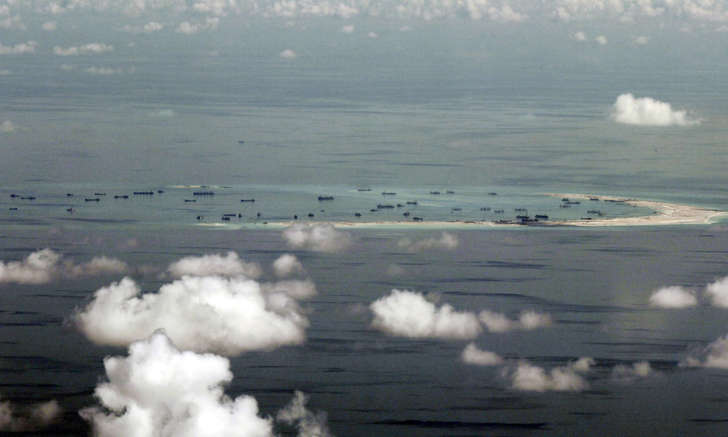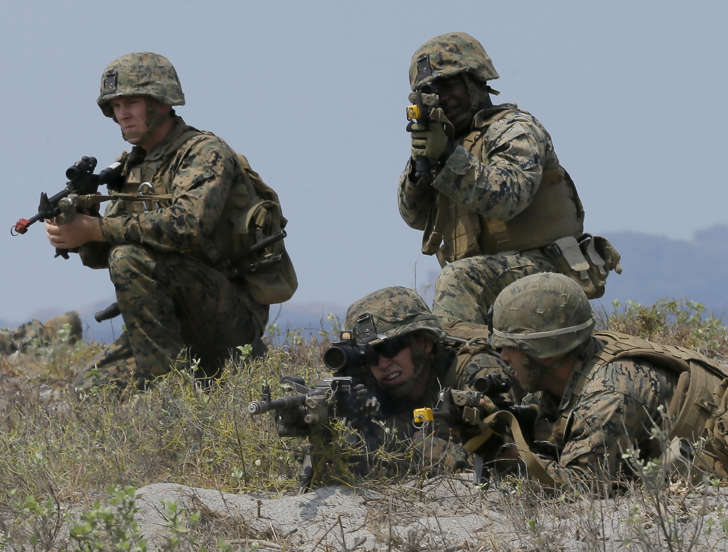 window of a Philippine military plane shows the alleged on-going land reclamation by China on mischief reef in the Spratly Islands in the South China Sea, west of Palawan…
window of a Philippine military plane shows the alleged on-going land reclamation by China on mischief reef in the Spratly Islands in the South China Sea, west of Palawan…
BEIJING — China said it was “deeply concerned” on Wednesday about a reported U.S. proposal to consider sending naval ships and aircraft toward man-made islands in the South China Sea as tensions escalate between the two nations over the vital waters.
The Obama administration has looked on with mounting frustration in recent months as China has undertaken a vast program of land reclamation in the South China Sea, turning rocks and submerged reefs into islands capable of supporting airstrips and military facilities across some of the world’s busiest shipping lanes.
The fear, expressed by President Obama last month, is that China is using its “muscle” to bully smaller nations into accepting its sovereignty over disputed waters. But a volley ofverbal protests from the United States has fallen on deaf ears, and administration officials have been agonizing over how to rein China in without escalating military tensions to dangerous levels, experts say.
Until now, Washington has also appeared reluctant to impose real costs on Beijing over the issue and risk damaging other aspects of a wide-ranging bilateral relationship, foreign policy experts say. But the administration now appears to be seeking other options to counter the threat that China’s assertive — and at times aggressive — stance poses to vital U.S. interests.
“Reclamation isn’t necessarily a violation of international law, but it’s certainly violating the harmony, the feng shui, of Southeast Asia, and it’s certainly violating China’s claim to be a good neighbor and a benign and non-threatening power,” Daniel Russel, assistant secretary of state for East Asia, said in a telephone interview.
With Secretary of State John F. Kerry due in Beijing on Saturday, a high-level dialogue between the two nations scheduled for June in Washington and Chinese President Xi Jinping paying a state visit to the United States in September, Russel said there were still plenty of diplomatic avenues open to influence China’s decision-making.

assault exercise at a beach facing one of the contested islands off the South China Sea known as Scarborough Shoal in the West Philippine Sea, April 21, 2015 at the Naval…
“Not every problem is best dealt with by imposing harsh and heavy consequences,” he said. “But sure, we are looking at the options available to us if persuasion and diplomacy doesn’t work.”
However, persuasion is not working, many experts say, and there are not many other easy options available. Sen. John McCain (R-Ariz.) has been among those advocating a more robust response but has not made many concrete suggestions, apart from disinviting Chinafrom the Rim of the Pacific, or RIMPAC, military exercise in 2016.
“That would be water off a duck’s back to Beijing,” said Ian Storey, a senior fellow at the Institute of Southeast Asian Studies in Singapore. He said China would send ships to carry our surveillance activities anyway, as it has in the past.
Another idea mooted by the Pentagon and first reported in the Wall Street Journal this week is to send U.S. naval ships and aircraft within 12 nautical miles of some of the man-made islands in the South China Sea to demonstrate the principle of freedom of navigation and underline that the United States does not accept China’s maritime claims — even if it does not endorse the territorial claims of rival nations.
As it does for a range of regional developments, the U.S. Pacific Command has drawn up contingency plans related to China’s buildup of artificial islands in the South China Sea, U.S. defense officials said.
The plans have not yet been examined at the most senior levels of the Obama administration, and officials said there had been no decision to immediately deploy assets near the artificial islands. Because the islands are in international waters, U.S. planes or ships could transit near them as a matter of course, the officials said.
Military and foreign policy analysts in Beijing, Washington and Manila said actions of this nature would not force China to halt its reclamation work or the construction of military, surveillance and other facilities on reclaimed land. But they said it might be seen as a way to send a stronger signal to Beijing and to reassure Asian allies and partners of Obama’s commitment to regional security.
“There is a bit of arrogance here in Beijing with respect to Southeast Asian nations, but they are watchful of their relationship with the United States,” said Yanmei Xie, senior China analyst with the International Crisis Group. “Until recently it appeared that China had gotten away with it. It seems the United States has struggled to come up with responses that could be effective but not escalatory — and China has not felt any tangible consequences.”
In 2013, China spooked the region and the United States by unilaterally declaring an air defense identification zone over much of the East China Sea, including over islands controlled by Japan. The United States responded by flying two B-52 bombers through the zone to underline that it did not recognize its legality.
Sending ships and planes toward newly constructed islands might serve a similar purpose. But it would not be without risks.
Chinese Foreign Ministry spokeswoman Hua Chunying expressed “deep” concern about the idea Wednesday and requested a clarification from the United States.
“The Chinese side advocates the freedom of navigation in the South China Sea, yet the freedom definitely does not mean that foreign military vessels and aircrafts can enter one country’s territorial waters and airspace at will,” she told a regular news conference. “. . . We urge parties concerned to be discreet in words and actions, avoid taking any risky and provocative actions and safeguard regional peace and stability.”
Storey said China would probably respond to any such actions by sending civilian coast-guard vessels up against U.S. warships in an attempt to portray the United States as the bully. There was also a risk, he said, of aggressive maneuvers between U.S. and Chinese warships.
In 2001, a midair collision between a U.S. surveillance aircraft and a Chinese fighter caused the death of a Chinese pilot and raised tensions between the two nations. In 2013, the USS Cowpens was forced to take sudden evasive action in the South China Sea when a Chinese naval vessel objected to its intelligence-gathering activities in international waters.
Still, some say the Pentagon’s suggestion is a good one, especially as the risks of less concrete action are mounting.
“The risk of damage to tranquil U.S.-China relations is high,” said Walter Lohman, director of the Asian Studies Center at the Heritage Foundation. “But in my opinion, that's a risk we have to run.”
Russel, the assistant secretary of state, said China’s reclamation work was already raising regional tensions and could further militarize the region. China’s bases on these islands could be used to block “rightful uses of international waters” by other nations, he warned. Fishing, surveillance activities, and oil and gas exploration by any number of countries could all be threatened if China uses bases on these new islands to mount more aggressive patrols, experts say.
Chinese bases would also make any future plan to impose an air defense identification zone over the South China Sea more credible, said Chris Johnson of the Center for Strategic and International Studies. “The PLA [People’s Liberation Army] have made it very clear they will declare one some day,” he said. “It is a question of when, not if.”
Gu Jinglu and Xu Yangjingjing in Beijing and Missy Ryan in Washington contributed to this report.

No comments:
Post a Comment